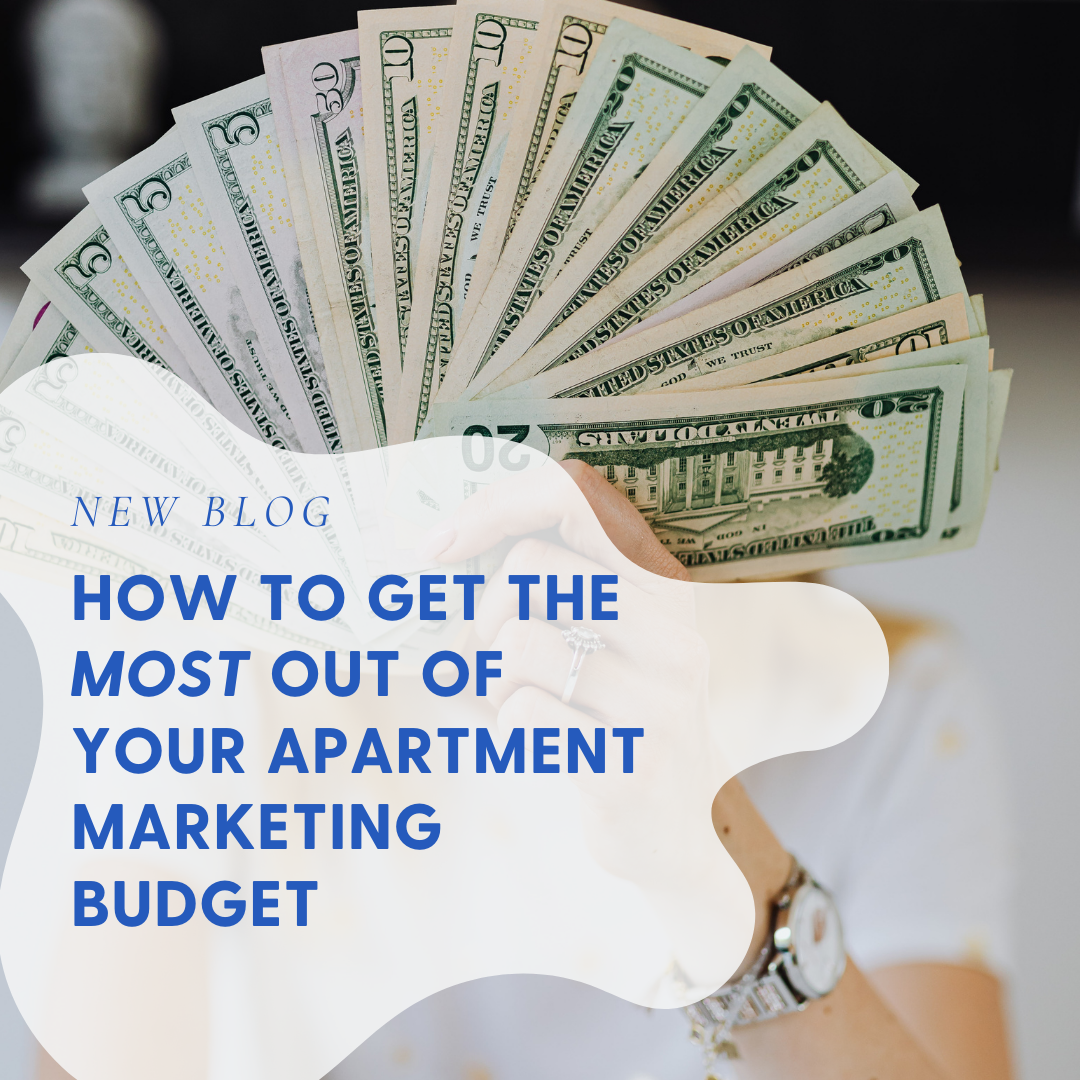
The time is quickly approaching for properties to take another look at their apartment marketing budget to decide which services will be the most beneficial for their property. Your apartment marketing budget allocation is the strategic distribution of financial resources towards various marketing channels. The key word is “strategic.” Think about the tactics you need to use to promote your apartment rentals. The things you choose to invest in have a direct impact on attracting potential tenants, filling vacancies, and ultimately, the profitability of your property.
Apartment marketing has evolved with advancements in marketing and technology. Traditionally, it involved print advertising and word-of-mouth. With the advent of the internet, digital marketing has taken precedence and that’s something you’ll need to consider when planning out your budget.
Deciding where to allocate a budget can be a big task, and it’s important to make decisions that will be rewarding for you and your community. With the right tips and tricks, you can ensure that your money is going to the right place.
A well-strategized budget will help increase your online visibility, grow your leads, and better your property. Plus, effective marketing and budget placement will help you expand your property and take you to the next level. Recent studies show a shift with over 60% of marketing budgets going to online channels, up from 40% five years ago.

Budgeting Basics for Apartment Marketing
Setting a realistic budget is the cornerstone of effective apartment marketing. Smart apartment marketing budget allocation and optimization means balancing spending across various channels for maximum impact and efficiency. It’s like planning a road trip; you need to know how much fuel you can afford and how far it can take you. In the world of apartment marketing, this fuel is your budget, and the distance is your marketing reach. Focusing on apartment marketing efficiency ensures that every dollar spent translates into tangible results, like increased inquiries and tours. Start by evaluating your current financial situation. How much can you comfortably allocate to marketing without stretching your resources too thin?
Understanding cost per lead and cost per lease is crucial. Cost per lead tells you how much it costs to get a potential tenant interested, while cost per lease reveals the cost of sealing the deal with a new lease. By tracking these, you can identify which marketing tactics give you the best mileage for your money. For instance, if social media ads bring more interested prospects at a lower cost compared to print ads, it’s a sign to steer more of your budget in that direction.
Don’t put all your eggs in one basket. Diversify your marketing strategies to cover various platforms – digital, print, and word-of-mouth. It’s like having different routes to reach a destination; if one road is blocked, you have alternatives. Allocate funds to tried-and-tested methods, but also set aside a portion for experimenting with new tactics. Effective rental property advertising involves a mix of digital and traditional methods, tailored to target the specific demographic of potential renters. This approach keeps your marketing dynamic and adaptable to changing trends and tenant preferences.
How Much Do Property Managers Spend
Understanding the average spending by property managers on marketing is essential. It’s a balancing act: investing enough to reel in leads, but not so much that it strains your resources. Generally, property managers allocate a portion of their annual revenue to marketing, ranging from 3% to 10%. However, this percentage can vary widely based on factors like property size, location, and target market.
For new properties, especially those in the lease-up phase where the building is still under construction, this percentage often skews higher. Why? Because these properties face the unique challenge of filling up numerous units from scratch. It’s like starting a new school – you need to spread the word to get students. For such properties, marketing spending can occasionally soar to as much as 20% of the expected annual rental income. This heightened budget reflects the urgency and scale of marketing required to attract tenants to a brand-new property.
It’s important to note that these numbers aren’t set in stone. Savvy property managers constantly fine-tune their budgets, guided by market trends, tenant demographics, and the effectiveness of their current marketing strategies. They use a mix of tried-and-tested methods like online listings and social media campaigns, while also exploring innovative approaches like virtual tours or micro-influencer partnerships.
Follow our guide below to learn more about where you can spend and where you can save.
1. Review Your Current Marketing Plan
To understand more about where your advertising dollars are going, dive into exactly what results are coming from your budget. Don’t let the wrong services drown your wallet by using unproductive methods. As you rework your budget, consider how well your current apartment marketing efforts are performing. Work with marketing experts to discover the different strategies that you should try.
Evaluate all of your apartment marketing options, including web listings, social media, and email marketing campaigns, to start. To find out which channels are providing the most leads and which may need to be altered or phased out, look at the data and metrics. You may increase your marketing ROI and reallocate your efforts to the most efficient channels with the aid of this information.
2. Explore A Variety Of Services
If you’ve been spending your apartment marketing money on only one service for a long time, it’s probably time to switch it up. There are many marketing options available, so it’s crucial to find the ones that will maximize your efforts while staying within your budget. Many properties often allocate all their funds to a large Internet Listing Services page. While this may partially work, it limits your reach and online visibility potential.
Explore adding services such as reputation management, a new custom website, SEO, PPC, virtual tours, and more. Investing in website development not only enhances your online presence but also significantly boosts engagement with potential tenants through a user-friendly and informative platform. With the right toolset and team behind you, you can excel far beyond what you have previously accomplished.
Having navigated through various marketing strategies, at Market Apartments, we’ve learned that a well-rounded approach pays off. For example, investing in SEO and a strong online presence has consistently brought higher quality leads compared to traditional print ads. SEO leads have a 14.6% close rate, compared to 1.7% for traditional outbound methods.
Don’t assume you know exactly where your target audience is looking for apartments. Make time for user research so that you can put your money into the most effective avenues. Those doing senior living marketing might assume they won’t reach seniors online, but today that isn’t the case. A property marketing towards young college students might assume TikTok or Instagram are the best ways to reach their audience and neglect targeted ads, email campaigns, or the power of print marketing. Try things out, see what is working, and reevaluate as you go.
New tenants can come to you in a variety of ways, so don’t stop at one marketing option. Take time to create a complete strategy and follow up to maximize your marketing efforts.
The Power of Micro-Influencer Partnerships: Collaborating with local micro-influencers can be a cost-effective way to reach potential tenants. Unlike major influencers, micro-influencers often have a highly engaged local following. A survey by Markerly found that influencers with fewer followers have higher engagement rates, making them ideal partners for targeted local marketing campaigns.
Contrary to popular belief, we’ve found that partnerships with local community figures and businesses can be just as effective as micro-influencers. By collaborating for local events or promotions, our clients observed a noticeable increase in brand visibility and community engagement.

3. Adjust To New Trends
Marketing trends are always changing and evolving. Not only does your audience want different things now than it did years ago, but Google and other search engines also regularly change the way that your site ranks. It’s important to regularly update and be aware of these changes so that your site can continue to do well and you can reach people in a way that works. With the right apartment SEO strategies, you can maintain and enhance your site growth. Stay on top of the latest apartment trends and changes, and jump into better apartment marketing.
4. Diversify Your Spending
It can be easy to fall into the trap of spending your multi-family marketing budget in one place. To ensure that your efforts reach your target audience, you should aim to diversify your spending. Placing your spending in one location online can result in fewer leads and poor growth. Consider leveraging your budget for a variety of services so that you can increase your brand and property awareness.
One common misconception our team has encountered is that more spending equals more visibility. In reality, strategic spending, focused on targeted audiences and platforms, often yields better results than a scattershot approach to budget allocation.
In the long run, this will help you appear more places online and bring you more leads from different sources. Let apartment marketing agencies help you know where you should place your budget. With the right guidance, you can truly transform the number of leads that you receive. Apartment advertising begins and ends with the right budget allocation.

5. Maintain Your Growth
The chances are that you have gained new web traffic, a strong audience, and more leads in the past year. Don’t let a new budget be the reason that you lose everything that you have gained! Many properties make the mistake of taking away the budgets that they have used for PPC, SEO, and beyond.
Doing so can harm your leads and can result in a downward slope in your growth. Be sure that you work with SEO and PPC experts who can help you understand exactly where your budget needs to be.
6. Make Data-Driven Decisions
Data-driven decision-making stands as a beacon, guiding property managers and marketers towards more effective budget allocation.
Conducting thorough market analysis in property management helps in identifying the most effective marketing channels and tenant preferences. This approach is not just about tracking numbers; it’s about understanding the story they tell and using that knowledge to make smarter, more impactful decisions.
Consider the power of campaign performance analysis. By closely monitoring which marketing strategies yield the highest number of leads or the most cost-effective leases, you can pinpoint where your budget is working hardest for you. If your social media campaigns are blossoming, drawing in prospects at a lower cost than traditional advertising, it’s a clear signal to channel more resources in that direction. This strategic shift ensures that every dollar spent is an investment in your property’s growth and visibility.
Moreover, embracing a variety of analytical tools to track and evaluate your marketing efforts is crucial. Tools like Google Analytics offer a comprehensive view of your marketing performance, providing insights into website traffic, email open rates, and engagement metrics on social media platforms. By analyzing this data, you can identify trends, understand tenant preferences, and adapt your strategies accordingly.
This continuous process of evaluation and adjustment is key to staying ahead in the competitive world of apartment marketing. It’s about making informed decisions that not only save money but also amplify your reach and effectiveness in attracting the right tenants.
7. Target the Right Audience
Understanding your target audience is like unlocking a secret code in apartment marketing. Imagine you’re throwing a party. You wouldn’t prepare the same food for a group of toddlers as you would for a team of athletes, right? The same goes for marketing. It’s crucial to know who you’re inviting to your property – your ideal residents. This starts by creating a resident persona, a detailed profile of your target tenant.
Consider factors like age, income level, lifestyle, and housing needs. Are they young professionals, students, or families? What are their daily routines, hobbies, or interests? This understanding is not just about demographics; it’s about getting into their shoes, seeing the world from their balcony.
Once you’ve painted a picture of your ideal resident, it’s time to speak their language. Tailoring your marketing messages to resonate with them is like choosing the right bait for the fish you want to catch. If you’re aiming for young professionals, highlight amenities like high-speed internet or a home office space. For families, focus on safety features, nearby schools, or kid-friendly facilities. Use language and imagery that echo their desires and aspirations.
Make sure you find a variety of ways to reach potential tenants and work to engage with them. Personalization in email marketing can significantly increase engagement rates. According to Campaign Monitor, emails with personalized subject lines are 26% more likely to be opened. Apartment marketers can use data from website interactions and inquiries to personalize communications and offers, making them more relevant to each recipient.
In your social media ads, emails, or website content, every word, every image should whisper, “This is the place for you.” By aligning your marketing strategies with the specific needs and preferences of your target audience, you convert general interest into genuine leads. It’s about creating a connection that goes beyond just an available apartment – it’s about offering them a home that feels like it was made just for them.
8. Build Brand Awareness
This concept is central to getting the most from your apartment marketing budget. By creating a consistent and compelling brand identity, you differentiate your property from competitors, ensuring that when potential residents think of their ideal home, they think of you.
Start by defining your brand’s unique story and values. What makes your property different? Maybe it’s your focus on community events, eco-friendly living, or luxury amenities. This brand story becomes your beacon, guiding all your marketing efforts, from your website to social media. 72% of millennials find their apartments through social media platforms. It’s about painting a picture of life at your property that resonates with your target audience. For instance, if your community is vibrant and youthful, your branding might be bright, modern, and full of energy.
A strong brand identity does more than just attract attention; it builds trust and recognition, which are invaluable in the long run. It’s a cost-saving strategy because a well-established brand requires less effort and money to market. People remember and talk about brands they feel connected to. Word-of-mouth, the most powerful and cost-effective marketing tool, becomes stronger with a recognizable brand. When your property’s name becomes synonymous with a certain quality or lifestyle, you’ll find that attracting the right residents becomes easier, and your advertising dollars go further.
9. Offer Compelling Incentives
Offering compelling incentives in your apartment marketing strategy is a savvy way to attract potential renters while optimizing your budget. Think of it as a magnet that pulls in the right crowd. Special promotions like a month of free rent, discounted security deposits, or complimentary amenities can be a game-changer. These offers not only grab attention but also create a sense of urgency, motivating prospects to act quickly.
This approach saves money in the long run. By offering targeted incentives, you’re likely to fill vacancies faster, reducing the time and resources spent on continuous marketing efforts. Additionally, these promotions can be tailored to specific audiences or times of the year, maximizing their impact. For example, offering a rental discount to students during the back-to-school season can lead to a surge in leases from this demographic. This targeted strategy ensures that every dollar spent is an investment in attracting the ideal residents, ultimately boosting your property’s occupancy and reputation.
10. Streamline the Leasing Process
In the dynamic landscape of apartment marketing, streamlining the leasing process is a game-changer. By focusing on user-friendly websites, responsive communication, and efficient application processing, property managers can not only enhance the tenant experience but also drive cost savings. This section explores practical strategies for optimizing the leasing journey, providing property managers with actionable insights on how to convert leads into leases while effectively managing their marketing budget.
- Leveraging User-Friendly Websites: An apartment community website is often the first point of contact for potential tenants. A well-designed, intuitive site that simplifies the leasing process is crucial. Ensure your website features easy navigation, clear calls to action, and an efficient online application system. Integrating virtual tours and detailed property descriptions can significantly reduce the need for in-person visits, saving time and resources. On top of that, a strong online presence with SEO optimization ensures higher visibility, attracting more leads without the need for extensive advertising.
- Prioritizing Responsive Communication: Timely and effective communication is the cornerstone of converting leads. Implementing automated response systems and chatbots can provide immediate answers to common queries, maintaining engagement. Personalized email follow-ups and SMS alerts about application status or upcoming appointments keep prospects informed and interested. This proactive approach reduces the time spent on manual follow-ups, streamlining staff efforts and leading to quicker lease conversions.
- Optimizing Application Processing: An efficient application process is key to closing leases quickly. Streamlining paperwork through digital applications and e-signatures not only speeds up the process but also reduces administrative costs. Offering clear guidelines and a checklist of required documents simplifies the process for applicants, enhancing their experience. By making the application process smooth and hassle-free, properties can increase their conversion rate, thereby maximizing the effectiveness of their marketing budget.
Points to Consider
- Regular Marketing Audits: Conduct bi-annual audits of your marketing strategies to ensure effectiveness.
- Track Competitor Strategies: Monitor competitors’ marketing tactics to stay ahead of the curve.
- Use Data Analytics: Regularly analyze your marketing data to understand tenant behavior and preferences.
- Experiment with New Channels: Don’t hesitate to try new marketing channels, but track their ROI.
- Focus on Tenant Satisfaction: Happy tenants are likely to refer others, making resident satisfaction a key marketing tool.
Remember, whatever strategies work best for you and your property are the ones you should focus on. Getting your budget right can revolutionize the success of your apartment marketing, so pay attention to what works and adjust what doesn’t. And, if you need some extra help getting your marketing strategy set up, reach out to experts! With such a highly competitive industry, you can’t afford to get your budget wrong. Reach out today!
Categorised in: Apartment Marketing
This post was written by Isabella Housel
Isabella Housel is a passionate and versatile professional writer with a deep love for words and a commitment to crafting compelling content that engages, informs, and inspires. With many years of experience in the industry, she has honed her skills across various genres, from creative storytelling to informative articles and technical documentation.





